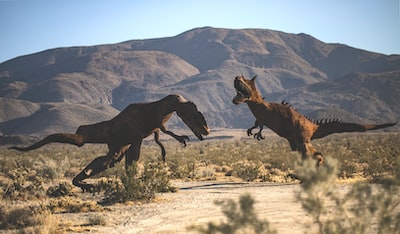The Enigma of Dinosaur Extinction: Unraveling the Mysteries of the Cosmos
Greetings, dear readers! It is I, spacerfit, your trusty blogger, here once again to take you on a journey through the vast expanse of our universe. Today, I’d like to delve into a topic that has always fascinated me—the extinction of dinosaurs. It is one of the most enigmatic events in the history of our planet, shrouded in mystery and speculation. What caused the sudden disappearance of these magnificent creatures that once roamed the Earth? Was it a natural disaster, a cosmic event, or something else entirely?
Join me on this journey, as we explore the many theories and hypotheses that have been put forward over the years. We’ll take a closer look at the fossil record, examine the geological evidence, and consider the climatic changes that occurred during the late Cretaceous period. We’ll also ponder the cosmic mysteries and secrets of our past, and ask ourselves what role the universe may have played in this cataclysmic event.
So, sit back, relax, and let’s embark on this exciting adventure together. Together, we’ll seek to unravel the mysteries of the past and shed light on one of the greatest events in the history of our planet.
1. The Enigma of Dinosaur Extinction
The extinction of dinosaurs is one of the most fascinating and mysterious events in Earth’s history, which occurred approximately 65 million years ago. This event is shrouded in multiple theories and hypotheses, drawing from fields such as astronomy, geology, and biology. Some theories suggest that a massive asteroid impact was the cause of their extinction, while others argue that volcanic activity or climate change had a significant role to play. Despite the many theories that exist, the exact cause of the extinction of dinosaurs remains a mystery, making it a captivating subject for scientific exploration. Scientists are still conducting research to understand the various factors that may have contributed to the extinction of these magnificent creatures, and their findings continue to generate exciting new questions and hypotheses. Indeed, the extinction of dinosaurs is a fascinating topic that continues to captivate the imagination of scientists and laypeople alike, and it serves as a reminder of the many mysteries that remain to be solved in our world.
2. Asteroid Impact: Catastrophe from the Cosmos
One of the most widely accepted theories explaining dinosaur extinction involves an asteroid impact. Around 65 million years ago, it is highly likely that a large asteroid or comet collided with Earth. This collision is thought to have caused a series of catastrophic events, which ultimately led to the extinction of the dinosaurs.
The asteroid impact would have released an immense amount of energy, leading to chemical reactions in the atmosphere. These reactions would have created a layer of dust and debris that blocked out the sun, causing a global cooling effect. This cooling effect would have disrupted the food chain, as plants were unable to photosynthesize and many animals were left without a source of food.
In addition to the cooling effect, the asteroid impact would have also caused earthquakes, tsunamis, and wildfires. These events would have further disrupted the ecosystem, causing widespread devastation.
Despite the widespread acceptance of the asteroid impact theory, there are still some scientists who argue that other factors, such as volcanic activity or climate change, may have also played a role in the extinction of the dinosaurs. However, the asteroid impact theory remains the most widely accepted explanation for this catastrophic event in Earth’s history.
2.1. Sulfuric Gases and Acidic Haze
The impact of the event under consideration would have caused the release of large amounts of sulfuric gases into the atmosphere, which in turn would have given rise to an acidic haze that would have enveloped the planet. This haze would have reduced the transparency of the atmosphere to sunlight, significantly decreasing the amount of heat that reached the surface of the Earth, resulting in a drastic drop in temperatures. These environmental changes, in turn, would have had devastating effects on the planet’s flora and fauna. The drop in temperature would have caused widespread crop failures and a significant reduction in the food supply. The reduced transparency of the atmosphere would also have disrupted the natural balance of the planet’s ecosystems, leading to a sharp decline in the populations of many species. It is likely that the effects of this event were felt for many years, if not decades, after it occurred, and it may have taken millions of years for the planet to fully recover from the damage caused by the impact.
3. Massive Volcanic Activity: Shaping Earth’s Environment
There is another theory that suggests that massive volcanic activity could have led to abrupt environmental changes in the past. When a volcano erupts, it releases an enormous quantity of gases and volcanic ash into the atmosphere, which can have a significant impact on the environment. For example, the release of sulfur dioxide could have caused an increase in the greenhouse effect, leading to a sudden drop in global temperatures. This sudden change in temperature could have had a major impact on the environment, including the extinction of certain species and the emergence of new ones. Furthermore, the ash and debris from volcanic eruptions can blanket large areas of land, causing widespread damage to plant and animal life. It is important to study the effects of volcanic activity on the environment so that we can be better prepared for future volcanic eruptions and their potential impact on the planet.
4. Climate Change and Rising Sea Levels: Geological Impacts
Another perspective on the extinction of dinosaurs suggests that it was brought about by a combination of climate change and geological impacts. It is believed that significant climate shifts or rising sea levels could have had a profound impact on dinosaur habitats and ecosystems, leading to major changes in the vegetation and food sources available to them. These changes might have posed severe challenges to their survival, as they would have had to adapt to new and unfamiliar conditions. In addition, geological events such as volcanic eruptions and asteroid impacts could have also contributed to the decline of the dinosaurs. These events would have caused widespread devastation and altered the landscape, making it even more difficult for these magnificent creatures to survive. Overall, it is likely that a combination of factors led to the extinction of the dinosaurs, and while we may never know the full story, it is fascinating to speculate about what might have happened all those millions of years ago.
5. Biological Factors: Diseases and Competition
Lastly, we must consider not only biological factors, but also environmental and ecological ones. It is important to understand the complex interplay between these various factors in order to get a clearer picture of the reasons behind the decline and eventual extinction of the dinosaurs. For instance, it is believed that changes in climate and geography, such as the breaking up of continents and the resulting changes in sea levels and weather patterns, could have had a significant impact on dinosaur populations. In addition, the interactions between different species, including predators and prey, could have played a role in the decline of certain species. For example, the emergence of new predators or the disappearance of key prey species could have led to a decrease in population size and genetic diversity, making the dinosaurs more vulnerable to extinction. Ultimately, it is likely that a combination of these and other factors contributed to the eventual extinction of the dinosaurs, and it is important to continue studying these issues in order to gain a more complete understanding of this fascinating period in Earth’s history.
6. Conclusion
Dinosaur extinction is a fascinating topic that has long perplexed scientists and laypeople alike. There are numerous theories and hypotheses that attempt to explain this prehistoric mystery, and research in fields such as astronomy, geology, and biology continues to shed light on this complex phenomenon. Some of the factors that may have contributed to the extinction of the dinosaurs include climate change, asteroid impact, volcanic activity, and changes in sea level. While each of these factors has been studied in depth, no single cause has been definitively proven, and it is likely that the extinction was the result of a complex interplay of various factors. Nevertheless, ongoing research serves to deepen our understanding of this fascinating topic and may ultimately help to uncover the truth behind this prehistoric mystery.
The history of our universe and Earth is incredibly rich and complex, with countless mysteries and wonders that continue to captivate and inspire us. One of the most fascinating enigmas of our planet’s past is the extinction of the dinosaurs, which has long puzzled scientists and researchers alike. While we may never know for certain what led to the demise of these magnificent creatures, ongoing research and exploration is shedding new light on this ancient mystery and opening up exciting new avenues for discovery and understanding. By delving deeper into the complexities of our cosmos, we can hope to gain a better understanding not just of our planet’s past, but of the broader forces and phenomena that have shaped the universe as we know it today.
I hope this article has been able to provide you with a glimpse into the mystery surrounding the extinction of these ancient creatures that once roamed the earth. The theories and evidence presented in this article point towards a variety of possible causes, each with its own set of strengths and weaknesses. However, one thing is certain – the disappearance of dinosaurs marked a significant turning point in the history of our planet. It is fascinating to ponder what might have been if they had survived and how the course of evolution might have been different. If you have any further queries or would like to delve deeper into this topic, please do not hesitate to leave a comment. Your feedback is greatly appreciated and I am grateful for the opportunity to take you on this journey through our planet’s past.







